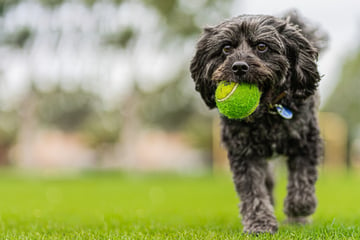Guard dog training: How to protection train your dog
There are some very alluring reasons why a guard dog might be a good idea, but it's not generally necessary. If you need one, though, how do you train guard dogs to protect and look after you?

Sometimes you need a little bit of security, someone or something to keep you safe at home and help you feel better about things. Whether a guard dog is the right solution to such a conundrum is a difficult conversation to have, and there are valuable points on each side. That being said, what needs to be known about guard dogs?
In this dog guide, TAG24 will take you through the ins and outs of guard dog training. How do you train a protection dog, and should you? Here's everything that you need to know.
Should you get dog protection training?
Guard dogs are important for a few people in very specific contexts, but should be far rarer than they are. If you are a family living in the suburbs, in a safe area, with few things to worry about, there may not be a reason to have a guard dog. On the other hand, if you need to protect a private business, it's not such a bad idea.
The reality we all have to contend with is that guard dogs are frightening for your friends and extended family. They are trained to be protective, and are trained to make sure that no intruder passes unscathed, so things get difficult if you happen to own one in a situation where it is both unnecessary and inappropriate (for example, in the suburbs).
These particular pooches are meant to fend off invaders and deal with wild animals in the context of a farm or a large piece of rural land. A well-trained guard dog will sniff out the threat, make a lot of noise, and will find a way to neutralize it. If you need to protect goods, equipment, or livestock, then perhaps they are worth considering.
There are two possible answers to whether you need to get dog protection training: 1) Yes, you need a guard dog to protect your business or in the context of policing; 2) No, you don't need a giant and aggressive dog living in your suburban house.
How to train a guard dog
The answer to this question is more straight forward than you'd expect: You shouldn't train a guard dog, that is a job for professionals. Ultimately, protection dogs are the business of professional guard dog trainers and not private citizens. If you feel the need to own one, an appropriate guard dog breed that has already been trained should be adopted from a trainer.
All this being said, there are a few things worth noting about the training process of a guard dog. It's complicated, and will require continued support even after the dog is in service. Shall we take a look?
Here's how a guard dog is professionally trained
Step 1: The first, and possibly most important part of the process is getting the dog properly socialized. From an early age, a guard dog will be exposed to a variety of people, animals, places, and situations, to make them used to the world and beat out any fear or uncertainty a dog would usually have.
Step 2: Basic obedience training follows, including things like getting them taught the basic commands and words that all dogs are taught. It needs to be cemented in their brains that you are the head of their pack, and that your orders need to always be followed. This is is coupled with more physical training to keep them strong and agile.
Step 3: Communication is the most important part in the guard dog training process. Rules need to be drilled into them, with potential guard dogs vetted to make sure that they are capable of fulfilling their duties. Your dog needs to be capable of following orders and also changing its situation, mentality, and behaviors immediately and reliably when necessary.
Step 4: It's now time to teach them the specific skills that they need to fulfil their role. If they are protecting property, that will require different skills to a specific person. You need to remember that these are not therapy dogs, and will often act aggressively, so obedience needs to be coupled with the right skill set.
Step 5: The final part in the process is integration. There will be a period in which guard dogs need to adjust to their new environment and their job. During this period they will still need to spend a lot of time with their trainer. Indeed, throughout a guard dog's life it should be regularly checked on by qualified professionals.
Ultimately, guard dogs need time to adjust and melt into their role. They need to maintain their physical and mental fitness and need to be kept obedient. As such, the protection dog training process needs to continue throughout its entire service life.

What is dog attack training, and should I get it?
Attack dog training is a variant on guard dog training and focuses on chasing, holding, and attacking people or other animals. It is an incredibly dangerous thing, as the dog has often been trained to kill what it perceives to be a hostile target. As such, if the training isn't done correctly, an attack dog can be extremely dangerous and can cause a great deal of harm.
During training, attack dogs are made to not just bring attention to intruders, foreign adversaries or animals, but actively hunt that same target. This means that an attack dog needs to be able to actively read situations and respond accordingly. They are often exposed to gunfire and are regularly used by the military.
Considering the nature of not only attack dog training, but attack dogs themselves, it is for the most part illegal in a civilian context. These dogs are only meant for use by official organizations and people (such as the police and the military) – and that's for good reason. If exposed to the civilian population, attack dogs could quickly become incredibly dangerous.
No one should get an attack dog, and no one should have their dog trained to attack. In most places this will actually be a criminal offense, and either way, it's ethically and morally unacceptable - you would be putting a lot of people at risk.
Best guard dog training equipment

If you have a guard dog, then you will need a few bits of equipment to keep your dog under control and assist with the training. Most of this equipment is something that your protective trainer will have, but some of it needs to be picked up by you too. Don't worry, it's not much.
Here are a few things you will need if you have a guard dog:
- Harness: Get a proper harness and make sure that it is properly harness and leash trained. On top of that, when on duty your dog should always be wearing this harness.
- Leash: Your doggo needs to be trained to stop behaving aggressively as soon as you attach. This should be combined with the aforementioned harness to guarantee that you can always keep your guard dog under control when it's on duty.
- Rewards: It's important to have and provide rewards to your darling doggo when it behaves appropriately. Keep your dog happy and healthy.
- Boundaries: The land or area that your guard dog needs to protect should be well-defined. This means that there should be clear fences, clear boundaries, and clear responsibilities.
With these couple of things in place, as well as the continued support of your professional dog trainer, you can keep your guard dog happy and your property protected.
Dog protection and guard dog training should be professional
In this article, we have focused on the steps that will generally be taken by professional dog trainers who are preparing guard dogs for their roles. It is not a good idea to take these steps yourself and try to protection train a dog without the help of a professional. You need to make sure that the perfect pooch living in your home is safe for you and has been trained safely as well.
Guard dog training results in an animal that has been prepared for dangerous and confronting situations. That preparation needs to be thorough and that dog needs to be safe. Get it trained professionally, doing it yourself is inappropriate and unsafe.
Cover photo: Unsplash/Malcolm Lightbody




